
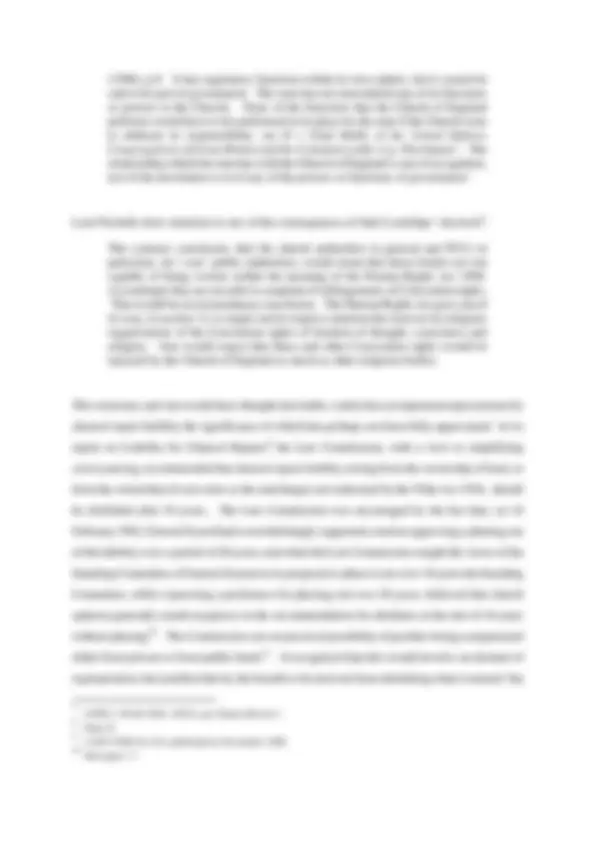
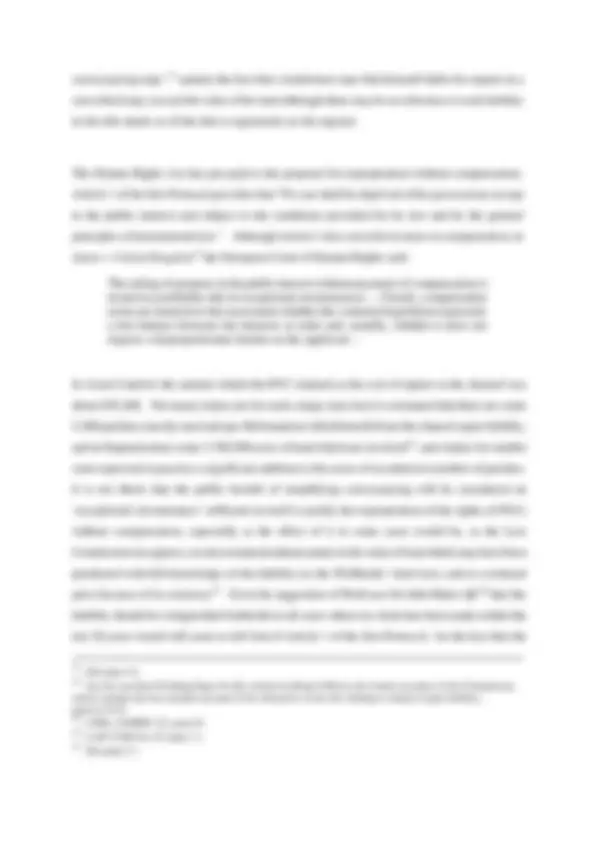
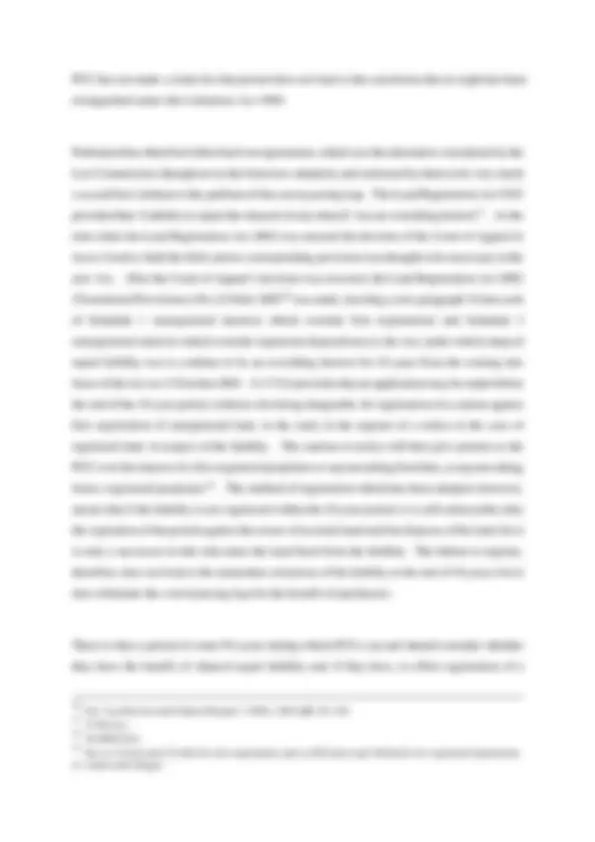
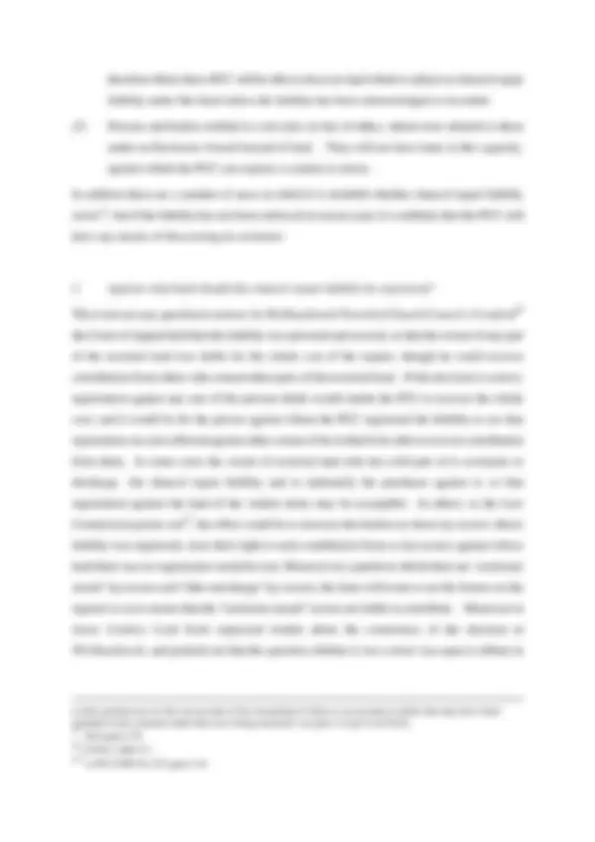
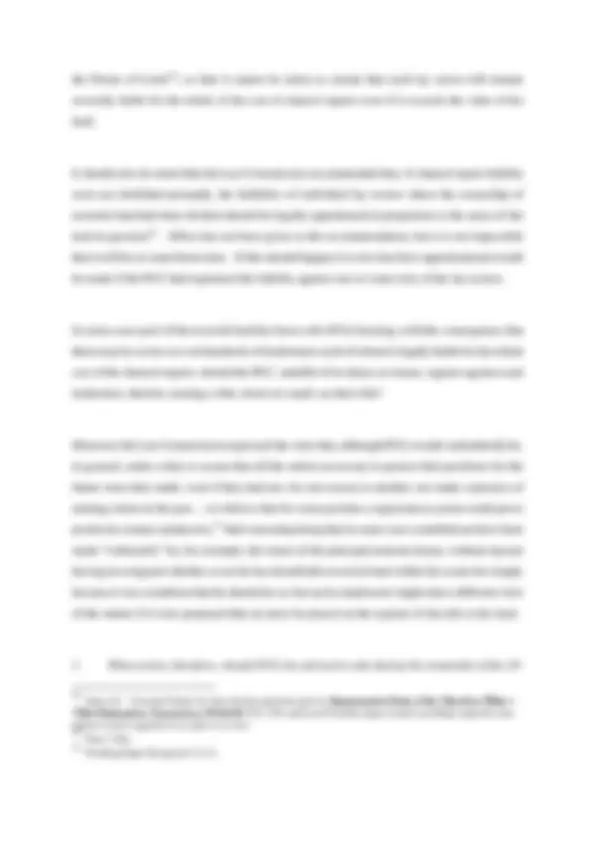
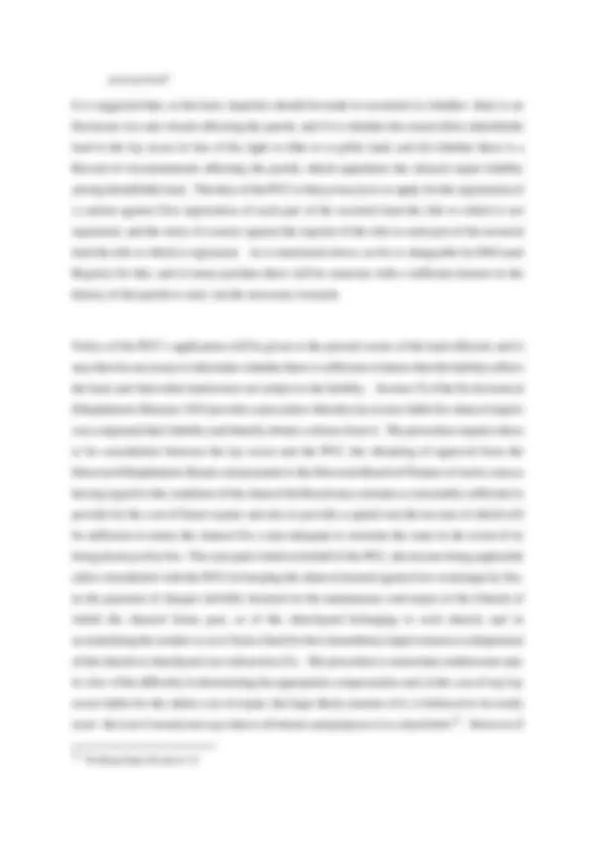


Study with the several resources on Docsity

Earn points by helping other students or get them with a premium plan


Prepare for your exams
Study with the several resources on Docsity

Earn points to download
Earn points by helping other students or get them with a premium plan
Community
Ask the community for help and clear up your study doubts
Discover the best universities in your country according to Docsity users
Free resources
Download our free guides on studying techniques, anxiety management strategies, and thesis advice from Docsity tutors
The legal case of Aston Cantlow and Wilmcote with Billesley Parochial Church Council v Wallbank, which determined that Parish Church Councils (PCCs) are not public authorities under the Human Rights Act 1998 and have no obligation to act compatibly with the European Convention on Human Rights. The document also explores the implications of this verdict for chancel repair liability, a private law liability arising from the ownership of land. It highlights the potential conveyancing trap and the significance of the Law Commission's recommendation to abolish chancel repair liability after a certain period. guidance on how PCCs can ascertain whether they have the benefit of chancel repair liability and what land carries this liability.
What you will learn
Typology: Lecture notes
1 / 11

This page cannot be seen from the preview
Don't miss anything!







Barrister
The two main aspects of the Aston Cantlow case^1 have been the subject of considerable academic interest 2. The first concerns the status of a parochial church council (‘PCC’)for the purposes of the Human Rights Act 1998, and by implication the status of many other church bodies under that Act. The second concerns the law relating to the liability of certain individuals and corporate bodies to repair the chancel of the parish church.
As is well known to readers of this Journal, the House of Lords, reversing the decision of the Court of Appeal, held that a PCC, in enforcing the liability of a lay rector to carry out or pay the cost of repairs to the chancel of the parish church, is not discharging the functions of a “public authority” within the meaning of section 6 of the Human Rights Act 1998, and has no obligation to act compatibly with the rights set out in the European Convention on Human Rights to which the Act gives effect; and that the respondents, Mr and Mrs Wallbank, were liable by virtue of their ownership of rectorial land to pay for the repairs to the chancel of Aston Cantlow parish church. The decision gave rise to letters in the press complaining that it was unfair, but the liability had been clear on the face of the title deeds of the Wallbanks’ land since at least 1875, and Mrs Wallbank’s parents (who gave the land to her) may well have paid a reduced price because of it.
The speeches of all five members of the Appellate Committee contain a valuable discussion of the character of the Church of England, which is well summarised in the headnote in the WLR:
Although the Church of England, as the established church, has special links with central government and performs certain public functions, it is essentially a religious organisation and not a governmental organisation. PCCs are part of the
(^1) Aston Cantlow and Wilmcote with Billesley Parochial Church Council v Wallbank , (2001)81 P & CR 14, [2000] 2 EGLR 149 (Ferris J); [2002] Ch 51, [2001] 3 All ER 393 (CA); [2003] 3 WLR 283, [2003] 3 All ER 1213 (HL). 2 See the Editor’s Note at (2004) 7 Ecc LJ 246 and the articles there referred to. See also Peter Cane, “Church, State and Human Rights: are Parish Councils Public Authorities” (2004), 120 LQR 41.
means whereby the Church promotes its religious mission and discharges financial responsibilities in respect of parish churches, and the functions of PCCs are primarily concerned with pastoral and administrative matters within the parish and are not wholly of a public nature, and therefore they are not core public authorities within s.6(1); and (Lord Scott dissenting) the fact that the public had certain rights in relation to their parish church is not sufficient to characterise the actions of a PCC in maintaining the fabric of the parish church as being of a public nature; so that when the plaintiff took steps to enforce the defendants’ liability for the repair of the chancel, it was not performing a function of a public nature which rendered it a hybrid public authority under s.6(3)(b). The defendants’ chancel repair liability is a private law liability arising out of the ownership of land, and the enforcement of that liability by the plaintiffs is an act of a private nature and therefore excluded by s.6(5) from coming within the ambit of s.6(3)(b).
As Lord Hope said^3 , ‘[The PCC] is seeking to enforce a civil debt. The function which it is performing has nothing to do with the responsibilities which are owed to the public by the State’. Lord Hope gave the fullest account of the legal position of the Church of England. Having pointed out that the implication of the Court of Appeal’s view that the PCC was a public authority was that other bodies such as diocesan and deanery synods and the General Synod fell into the same category, he said^4 :
In my opinion however the legal framework of the Church of England as a church by law established does not lead to this conclusion. The Church of England as a whole has no legal status or personality^5. There is no Act of Parliament that purports to establish it as the Church of England: Sir Lewis Dibdin, Establishment in England : Essays on Church and State (1932), p.111. What establishment in law means is that the state has incorporated its law into the law of the realm as a branch of its general law. In Marshall v Graham^6 Phillimore J said: “A Church which is established is not thereby made a department of the state. The process of establishment means that the state has accepted the Church as the religious body in its opinion truly teaching the Christian faith, and given to it a certain legal position, and to its decrees, if rendered under certain legal conditions, certain civil sanctions.” The Church of England is identified with the state in other ways, the monarch being head of each: see Doe, The Legal Framework of the Church of England
(^3) Para.64. (^4) Paras.60-61. (^5) This rather nebulous character of the Church of England was emphasised by Gerald Ellison, then recently retired as Bishop of London, in an address which he gave to the Partners in Mission Consultation at Hengrave Hall in May 1982: “The Church of England as such has never trained a priest, has never sent a missionary, has never opened a hospital.” Lord Rodger described the juridical nature of the Church as “notoriously somewhat amorphous” (para.154). 6 [1907] 2 KB 112, 126
conveyancing trap’,^12 namely the fact that a landowner may find himself liable for repairs in a sum which may exceed the value of his land although there may be no reference to such liability in the title deeds or (if the title is registered) on the register.
The Human Rights Act has put paid to the proposal for expropriation without compensation. Article 1 of the first Protocol provides that “No one shall be deprived of his possessions except in the public interest and subject to the conditions provided for by law and by the general principles of international law.” Although Article 1 does not refer in terms to compensation, in James v United Kingdom^13 the European Court of Human Rights said:
The taking of property in the public interest without payment of compensation is treated as justifiable only in exceptional circumstances. ... Clearly, compensation terms are material to the assessment whether the contested legislation represents a fair balance between the interests at stake and, notably, whether it does not impose a disproportionate burden on the applicant ...
In Aston Cantlow the amount which the PCC claimed as the cost of repairs to the chancel was about £95,260. Not many claims are for such a large sum, but it is estimated that there are some 5,200 parishes (mostly rural and pre-Reformation) which benefit from the chancel repair liability, and in England alone some 3,780,500 acres of land which are involved^14 , and claims for smaller sums represent in practice a significant addition to the assets of an unknown number of parishes. It is not likely that the public benefit of simplifying conveyancing will be considered an ‘exceptional circumstance’ sufficient in itself to justify the expropriation of the rights of PCCs without compensation, especially as the effect of it in some cases would be, as the Law Commission recognises, an uncovenanted enhancement in the value of land which may have been purchased with full knowledge of the liability (as the Wallbanks’ land was), and at a reduced price because of its existence15.^ Even the suggestion of Professor Sir John Baker QC^16 that the liability should be extinguished forthwith in all cases where no claim has been made within the last 20 years would still seem to fall foul of Article 1 of the first Protocol; for the fact that the
(^11) Ibid para 4.6. (^12) See the excellent Working Paper No.86, written by Brian O’Brien, the former secretary of the Commission, which contains the best modern account of the intricacies of the law relating to chancel repair liability, paras.6.19-22 13 14 (1986), 8 EHRR 123, para.54. 15 LAW COM No.152 para.1.2. Ibid para.4.7.
PCC has not made a claim for that period does not lead to the conclusion that its right has been extinguished under the Limitation Act 1980.
Parliament has therefore fallen back on registration, which was the alternative considered by the Law Commission (though not in the form now adopted), and reckoned by them to be very much a second best solution to the problem of the conveyancing trap. The Land Registration Act 1925 provided that ‘Liability to repair the chancel of any church’ was an overriding interest^17. At the time when the Land Registration Act 2002 was enacted the decision of the Court of Appeal in Aston Cantlow held the field, and no corresponding provision was thought to be necessary in the new Act. After the Court of Appeal’s decision was reversed, the Land Registration Act 2002 (Transitional Provisions) (No.2) Order 2003^18 was made, inserting a new paragraph 16 into each of Schedule 1 (unregistered interests which override first registration) and Schedule 3 (unregistered interests which override registered dispositions) to the Act, under which chancel repair liability was to continue to be an overriding interest for 10 years from the coming into force of the Act on 13 October 2003. S.117(2) provides that an application may be made before the end of the 10-year period, without a fee being chargeable, for registration of a caution against first registration of unregistered land, or the entry in the register of a notice in the case of registered land, in respect of the liability. The caution or notice will then give priority to the PCC over the interest of a first registered proprietor or anyone taking from him, or anyone taking from a registered proprietor^19. The method of registration which has been adopted, however, means that if the liability is not registered within the 10-year period, it is still enforceable after the expiration of the period against the owner of rectorial land until he disposes of his land; for it is only a successor in title who takes the land freed from the liability. The failure to register, therefore, does not lead to the immediate extinction of the liability at the end of 10 years; but it does eliminate the conveyancing trap for the benefit of purchasers.
There is thus a period of some 9½ years during which PCCs can and should consider whether they have the benefit of chancel repair liability and, if they have, to effect registration of a
(^16) See ‘Lay Rectors and Chancel Repairs’ (1984), 100 LQR 181,184. (^17) S.70(1)(c). (^18) SI 2003/2431. (^19) See ss.11(4)(a) and 12(4)(b) for first registration, and ss.29(2)(a)(i) and 30(2)(a)(i) for registered dispositions of estates and charges.
Parliamentary Enclosures in Wales (1992). Both the latter two books are available on open access at the National Archives, Kew; and a number of law libraries contain an indexed series of local and personal Acts in which Enclosure Acts are to be found. Tate estimates that enclosure awards cover about half of English parishes; and there are said to be about 2200 Enclosure Acts affecting individual parishes, though not all of them will necessarily have allotted land to the lay rector in lieu of tithe, the ownership of which carries with it the chancel repair liability.
(3) Landowners in whose land the right to tithe or tithe rentcharge has merged, either under the Tithe Act 1936 or under an earlier Tithe Act. These will be landowners who were entitled to tithe and whose right to tithe was not extinguished by an Enclosure Act or Award. The Tithe Redemption Commission appointed to put the 1936 Act into effect was required to compile, in relation to every chancel repairable by tithe rentcharge owners, a document known as the Record of Ascertainments. The proportionate liability for repairs to the chancel of ancient parish churches which was to be borne by the owners of tithe rentcharges was ascertained by the Tithe Redemption Commission and recorded in the volumes in this series. The apportionment of liability made in this way was, however, only legally effective as between the owners of land at the date it was made, and on a subsequent division of the land no further apportionment binding on the PCC would normally have taken place. The Public Record Office has again published a useful leaflet 24 on the subject, and holds 108 volumes of Records of Ascertainment at Kew, filed alphabetically by county and parish^25.
(4) Landowners whose land was originally part of the glebe of a parish but fell into lay hands on the dissolution of the monasteries. The Law Commission say that the chances of a piece of land being identifiable today as impropriated glebe are fairly remote, unless it is still in the hands of the original lay impropriator (such as an Oxford College) and the details of its acquisition are known. They are not aware of any litigated case in which the liability for chancel repairs has been based directly on the ownership of glebe, but there may well be acceptance of liability wholly or partly on that basis^26. It is not
cases the original Enclosure Awards may be found in the relevant county record office. 24 25 Legal Records Information Leaflet 33, available at^ http://catalogue.pro.gov.uk/Leaflets/ri2251.htm 26 Series IR104.^ For further details click on IR104 in the internet version of Leaflet 33, note 24 above. Working Paper 86 para.2.20; but it appears that the original rectorial property replaced by the lands in question in Chivers & Sons Ltd v Air Ministry , n.22 above, had included glebe; and in Aston Cantlow it was not clear whether the the Wallbanks’ land, which was known as Glebe Farm, was allotted by the Enclosure Award
therefore likely that a PCC will be able to discover land which is subject to chancel repair liability under this head unless the liability has been acknowledged or recorded.
(5) Persons and bodies entitled to corn rents in lieu of tithes, which were allotted to them under an Enclosure Award instead of land. They will not have land, in this capacity, against which the PCC can register a caution or notice.
In addition there are a number of areas in which it is doubtful whether chancel repair liability exists^27 ; but if the liability has not been enforced in recent years it is unlikely that the PCC will have any means of discovering its existence.
2. Against what land should the chancel repair liability be registered?
This is not an easy question to answer. In Wickhambrook Parochial Church Council v Croxford^28 the Court of Appeal held that the liability was personal and several, so that the owner of any part of the rectorial land was liable for the whole cost of the repairs, though he could recover contribution from others who owned other parts of the rectorial land. If this decision is correct, registration against any one of the persons liable would entitle the PCC to recover the whole cost; and it would be for the person against whom the PCC registered the liability to see that registration was also effected against other owners if he wished to be able to recover contribution from them. In some cases the owner of rectorial land who has sold part of it covenants to discharge the chancel repair liability and to indemnify the purchaser against it, so that registration against the land of the vendor alone may be acceptable. In others, as the Law Commission points out 29 , the effect could be to increase the burden on those lay rectors whose liability was registered, since their right to seek contribution from co-lay rectors against whose land there was no registration would be lost. Moreover in a parish in which there are ‘enclosure award’ lay rectors and ‘tithe rentcharge’ lay rectors, the latter will want to see the former on the register so as to ensure that the “enclosure award” rectors are liable to contribute. Moreover in Aston Cantlow Lord Scott expressed doubts about the correctness of the decision in Wickhambrook , and pointed out that the question whether it was correct was open to debate in
to their predecessor in title on account of the ownership of tithes or on account of glebe that may have been included in the common lands that were being enclosed: see para.112 per Lord Scott. 27 28 Ibid^ para.2.29. 29 [1935] 2 KB 417. LAW COM No.152 para.5.10.
year period?
It is suggested that, at the least, inquiries should be made to ascertain (a) whether there is an Enclosure Act and Award affecting the parish, and if so whether the award allots identifiable land to the lay rector in lieu of his right to tithe or to glebe land; and (b) whether there is a Record of Ascertainments affecting the parish, which apportions the chancel repair liability among identifiable land. The duty of the PCC is then prima facie to apply for the registration of a caution against first registration of each part of the rectorial land the title to which is not registered, and the entry of a notice against the register of the title to each part of the rectorial land the title to which is registered. As is mentioned above, no fee is chargeable by HM Land Registry for this; and in many parishes there will be someone with a sufficient interest in the history of the parish to carry out the necessary research_._
Notice of the PCC’s application will be given to the present owner of the land affected, and it may then be necessary to determine whether there is sufficient evidence that the liability affects the land, and what other landowners are subject to the liability. Section 52 of the Ecclesiastical Dilapidations Measure 1923 provides a procedure whereby lay rectors liable for chancel repairs can compound their liability and thereby obtain a release from it. The procedure requires there to be consultation between the lay rector and the PCC, the obtaining of approval from the Diocesan Dilapidations Board, and payment to the Diocesan Board of Finance of such a sum as having regard to the condition of the chancel the Board may estimate as reasonably sufficient to provide for the cost of future repairs and also to provide a capital sum the income of which will be sufficient to insure the chancel for a sum adequate to reinstate the same in the event of its being destroyed by fire. The sum paid is held on behalf of the PCC, the income being applicable (after consultation with the PCC) in keeping the chancel insured against loss or damage by fire, in the payment of charges lawfully incurred in the maintenance and repair of the Church of which the chancel forms part, or of the churchyard belonging to such church, and in accumulating the residue so as to form a fund for the extraordinary improvement or enlargement of the church or churchyard (see subsection (5)). The procedure is somewhat cumbersome and, in view of the difficulty in determining the appropriate compensation and, in the case of any lay rector liable for the whole cost of repair, the large likely amount of it, is believed to be rarely used - the Law Commission says that to all intents and purposes it is a dead letter^33. However if
(^33) Working Paper 86 para.3.15.
the alternative for the lay rector is an adverse entry on his title, he may find compounding for the liability is a more attractive alternative in future. Since each lay rector is severally liable for the whole of the cost of repairs, it will be almost essential to involve all those who own land to which the liability attaches in the procedure for compounding the liability.
As in other cases in which registration or some comparable procedure is made necessary if one is not to lose a well-established right, such as a right to water under the Water Resources Act 1963 or a right of common under the Commons Registration Act 1965, the requirement to register chancel repair liability is likely to give rise to the possibility of disputes where none existed previously, which is a matter for regret; but, unless vigorous and prompt steps are taken by PCCs to ascertain and protect the rights which the law gives them, there is a danger that a potentially valuable resource will be lost to the Church for ever.